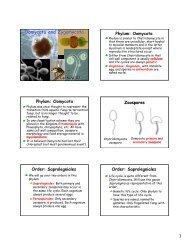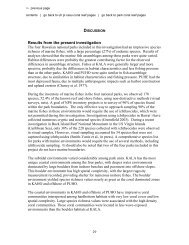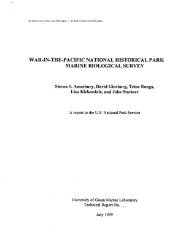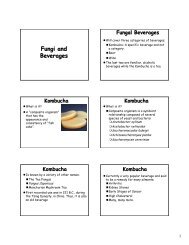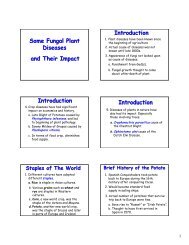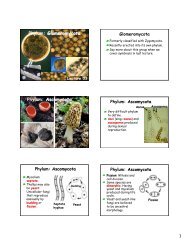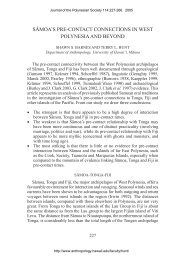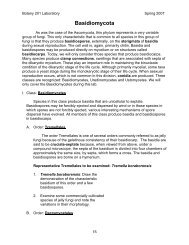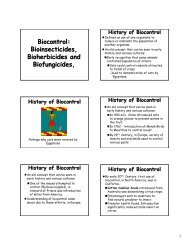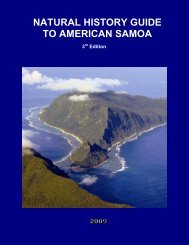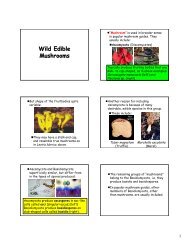american samoa - University of Hawaii at Manoa Botany Department
american samoa - University of Hawaii at Manoa Botany Department
american samoa - University of Hawaii at Manoa Botany Department
- No tags were found...
Create successful ePaper yourself
Turn your PDF publications into a flip-book with our unique Google optimized e-Paper software.
Further downstream, the stream channel becomes more narrow and rocky. N<strong>at</strong>ive forest treesalong the east and west stream banks included afa (Neonauclea forsteri), fuafua (Kleinhoviahospita), fau (beach hibiscus), and maota mamala (Dysoxylum samoense). Wetland trees suchas ifi (Tahitian chestnut) and falaga (Barringtonia samoensis), as well as cultiv<strong>at</strong>ed trees suchas ulu (breadfruit) also domin<strong>at</strong>ed this area. The ground cover consisted <strong>of</strong> basket grass, T-grass, and various weeds th<strong>at</strong> are characteristic <strong>of</strong> upland veget<strong>at</strong>ion.Lands adjacent to the lower portion <strong>of</strong> AsiliStream were more disturbed and containedcultiv<strong>at</strong>ed trees such as vi (Polynesian plum),beach hibiscus, coconut, and breadfruit. Rockwalls, concrete walls, and rock-filled gabionbaskets reinforced most <strong>of</strong> the stream banks.Where man-made flood control structures werenot present, barren soils and soils covered withweeds were observed. Some landscaped lawnsalso were also established immedi<strong>at</strong>ely abovethe stream banks.Between the stream mouth and the Route 1 bridge, a more lagoon type <strong>of</strong> environment wasevident. The seaward side <strong>of</strong> the stream channel contained modified littoral veget<strong>at</strong>ion.Veget<strong>at</strong>ion TrendsNo prior studies <strong>of</strong> the veget<strong>at</strong>ion <strong>of</strong> Asili Stream have been conducted. Consequently, nocorrel<strong>at</strong>ion can be made concerning historical veget<strong>at</strong>ive trends.The Asili Stream segment was probably once domin<strong>at</strong>ed by the same species th<strong>at</strong> wereobserved upslope <strong>of</strong> the village. This veget<strong>at</strong>ion comprises trees such as afa (Neonaucleaforsteri), fuafua (Kleinhovia hospita), fau, and maota mamala (Dysoxylum samoense).Wetland trees such as ifi and falaga are also present upstream <strong>of</strong> the village.The upper portion <strong>of</strong> the Asili Stream segment will probably remain in disturbed veget<strong>at</strong>ion aslong as residents continue to harvest and use crops from subsistence plant<strong>at</strong>ions. The middleand lower portions <strong>of</strong> the stream segment are also expected to remain generally the same.However, the amount <strong>of</strong> veget<strong>at</strong>ion along the stream banks may diminish somewh<strong>at</strong> if residentscontinue to build more flood control structures in response to future storm events.AQUATIC FISH AND INVERTEBRATESGeneralOn November 10, 1999, Charles Chong <strong>of</strong> the PPC field survey team made observ<strong>at</strong>ions <strong>of</strong>aqu<strong>at</strong>ic fish and invertebr<strong>at</strong>es along the 1,000-foot segment <strong>of</strong> Asili Stream. His observ<strong>at</strong>ionsare summarized in the following paragraphs.An overstory canopy covered much <strong>of</strong> the stream channel between the stream mouth and theinhabited residential area along the stream. Upstream <strong>of</strong> the village, the canopy over the streamwas more open.American Samoa Wetlands/Streams Restor<strong>at</strong>ion and Enhancement PlanFebruary 2001, Asili Stream, Page 10-7



